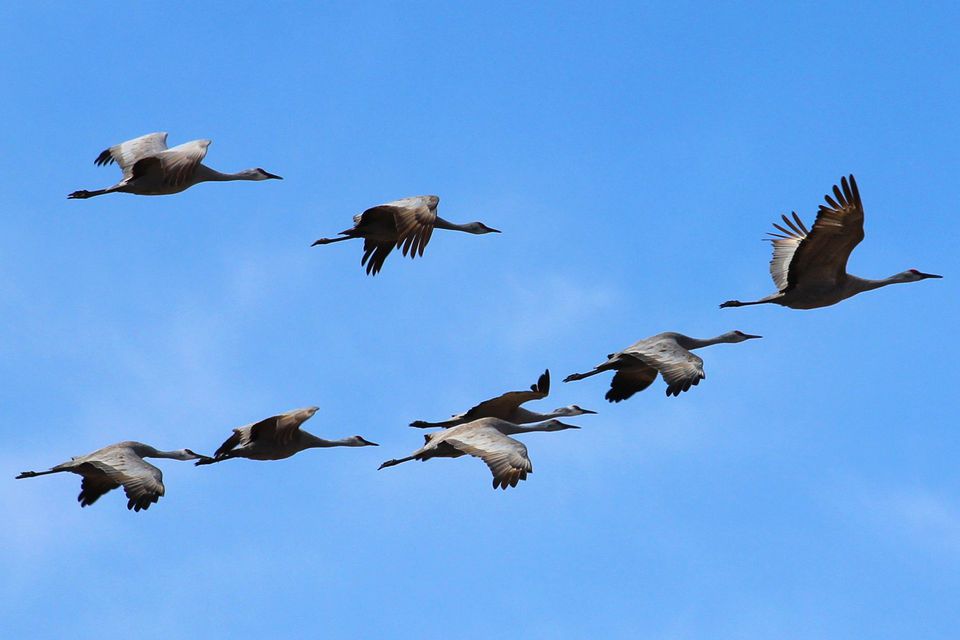Migration Of Birds – Zoology Notes – For W.B.C.S. Examination.
পাখির স্থানান্তর – প্রাণীবিদ্যা নোট – WBCS পরীক্ষা।
Zoology is purely a science subject, emerged as a scoring optional in W.B.C.S. Mains.Ideally, this subject cannot be taken by the students from any background. Aspirants must be a graduate in Zoology, Medicine, Botany, Life Science, Agriculture, Forestry etc.For scoring well, you need not choose an easy subject, but shed your sweat and blood on that subject you have chosen. One must be thorough with the basic fact and concepts. The conceptual clarity, it will help you to answer an indirect and twisted question as well.Geese winging their way south in wrinkled V-shaped flocks is perhaps the classic picture of migration—the annual, large-scale movement of birds between their breeding (summer) homes and their nonbreeding (winter) grounds. But geese are far from our only migratory birds. Of the more than 650 species of North American breeding birds, more than half are migratory.Continue Reading Migration Of Birds – Zoology Notes – For W.B.C.S. Examination.
Why Do Birds Migrate?
Birds migrate to move from areas of low or decreasing resources to areas of high or increasing resources. The two primary resources being sought are food and nesting locations.
Birds that nest in the Northern Hemisphere tend to migrate northward in the spring to take advantage of burgeoning insect populations, budding plants and an abundance of nesting locations. As winter approaches and the availability of insects and other food drops, the birds move south again. Escaping the cold is a motivating factor but many species, including hummingbirds, can withstand freezing temperatures as long as an adequate supply of food is available.Click here to read, Drain Theory – Economics Notes – For W.B.C.S. Examination.
Origins Of Long-Distance Migration
While short-distance migration probably developed from a fairly simple for food, the origins of long-distant migration patterns are much more complex. They’ve evolved over thousands of years and are controlled at least partially by the genetic makeup of the birds. They also incorporate responses to weather, geography, food sources, day length, and other factors.
For birds that winter in the tropics, it seems strange to imagine leaving home and embarking on a migration north. Why make such an arduous trip north in spring? One idea is that through many generations the tropical ancestors of these birds dispersed from their tropical breeding sites northward. The seasonal abundance of insect food and greater day length allowed them to raise more young (4–6 on average) than their stay-at-home tropical relatives (2–3 on average). As their breeding zones moved north during periods of glacial retreat, the birds continued to return to their tropical homes as winter weather and declining food supplies made life more difficult. Supporting this theory is the fact that most North American vireos, flycatchers, tanagers, warblers, orioles, and swallows have evolved from forms that originated in the tropics.
What Triggers Migration?
The mechanisms initiating migratory behavior vary and are not always completely understood. Migration can be triggered by a combination of changes in day length, lower temperatures, changes in food supplies, and genetic predisposition. For centuries, people who have kept cage birds have noticed that the migratory species go through a period of restlessness each spring and fall, repeatedly fluttering toward one side of their cage. German behavioral scientists gave this behavior the name zugunruhe, meaning migratory restlessness. Different species of birds and even segments of the population within the same species may follow different migratory patterns.
How Do Birds Navigate?
Migrating birds can cover thousands of miles in their annual travels, often traveling the same course year after year with little deviation. First-year birds often make their very first migration on their own. Somehow they can find their winter home despite never having seen it before, and return the following spring to where they were born.
The secrets of their amazing navigational skills aren’t fully understood, partly because birds combine several different types of senses when they navigate. Birds can get compass information from the sun, the stars, and by sensing the earth’s magnetic field. They also get information from the position of the setting sun and from landmarks seen during the day. There’s even evidence that sense of smell plays a role, at least for homing pigeons.
Some species, particularly waterfowl and cranes, follow preferred pathways on their annual migrations. These pathways are often related to important stopover locations that provide food supplies critical to the birds’ survival. Smaller birds tend to migrate in broad fronts across the landscape. Recent studies using eBird data are revealing that many small birds take different routes in spring and fall, to take advantage of seasonal patterns in weather and food.To know more about W.B.C.S. syllabus , click here.
Migration Hazards
Taking a journey that can stretch to a round-trip distance of several thousand miles is a dangerous and arduous undertaking. It is an effort that tests both the birds’ physical and mental capabilities. The physical stress of the trip, lack of adequate food supplies along the way, bad weather, and increased exposure to predators all add to the hazards of the journey.
In recent years long-distant migrants have been facing a growing threat from communication towers and tall buildings. Many species are attracted to the lights of tall buildings and millions are killed each year in collisions with the structures. The Fatal Light Awareness Program, based in Toronto, Ontario, Canada, has more about this problem.
Please subscribe here to get all future updates on this post/page/category/website


 +919674493673
+919674493673  mailus@wbcsmadeeasy.in
mailus@wbcsmadeeasy.in







































































































